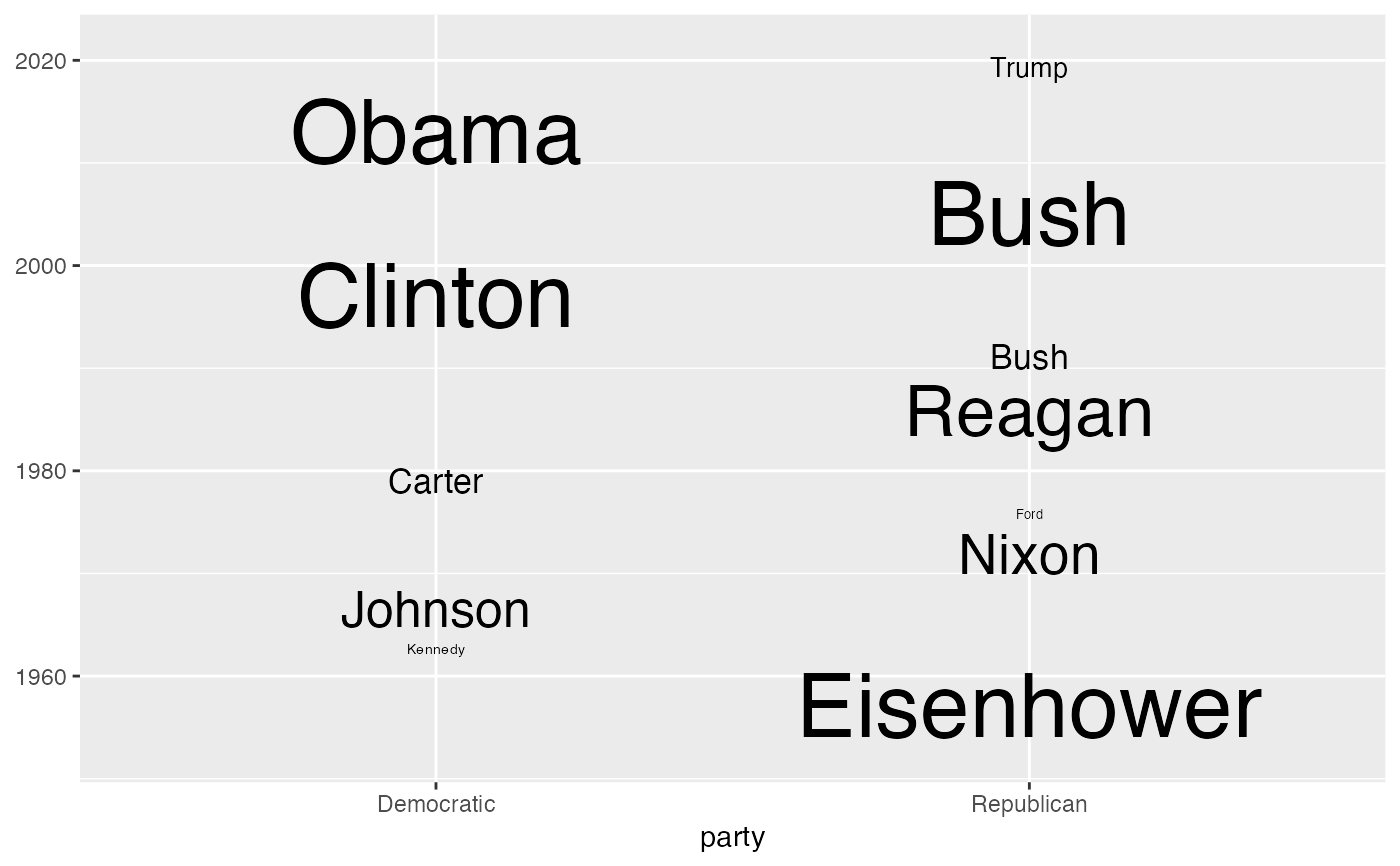A 'ggplot2' geom to fit text inside a box
Source:R/geom_bar_text.R, R/geom_fit_text.R
geom_fit_text.Rdgeom_fit_text() shrinks, grows and wraps text to fit inside a defined
box.
geom_bar_text() is a convenience wrapper around geom_fit_text() for
labelling bar plots generated with geom_col() and geom_bar().
Usage
geom_bar_text(
mapping = NULL,
data = NULL,
stat = "identity",
position = "identity",
na.rm = FALSE,
show.legend = NA,
inherit.aes = TRUE,
padding.x = grid::unit(1, "mm"),
padding.y = grid::unit(1, "mm"),
min.size = 8,
place = NULL,
outside = NULL,
grow = FALSE,
reflow = FALSE,
hjust = NULL,
vjust = NULL,
fullheight = NULL,
width = NULL,
height = NULL,
formatter = NULL,
contrast = NULL,
rich = FALSE,
...
)
geom_fit_text(
mapping = NULL,
data = NULL,
stat = "identity",
position = "identity",
na.rm = FALSE,
show.legend = NA,
inherit.aes = TRUE,
padding.x = grid::unit(1, "mm"),
padding.y = grid::unit(1, "mm"),
min.size = 4,
place = "centre",
outside = FALSE,
grow = FALSE,
reflow = FALSE,
hjust = NULL,
vjust = NULL,
fullheight = NULL,
width = NULL,
height = NULL,
formatter = NULL,
contrast = FALSE,
flip = FALSE,
rich = FALSE,
...
)Arguments
- mapping
ggplot2::aes()object as standard in 'ggplot2'. Note that aesthetics specifying the box must be provided. See Details.- data, stat, position, na.rm, show.legend, inherit.aes, ...
Standard geom arguments as for
ggplot2::geom_text().- padding.x, padding.y
Horizontal and vertical padding around the text, expressed in
grid::unit()objects. Both default to 1 mm.- min.size
Minimum font size, in points. Text that would need to be shrunk below this size to fit the box will be hidden. Defaults to 4 pt (8 pt for
geom_bar_text())- place
Where inside the box to place the text. Default is 'centre'; other options are 'topleft', 'top', 'topright', 'right', 'bottomright', 'bottom', 'bottomleft', 'left', and 'center'/'middle' which are both synonyms for 'centre'. For
geom_bar_text(), will be set heuristically if not specified.- outside
If
TRUE, text placed in one of 'top', 'right', 'bottom' or 'left' that would need to be shrunk smaller thanmin.sizeto fit the box will be drawn outside the box if possible. This is mostly useful for drawing text inside bar/column geoms. Defaults to TRUE forposition = "identity"when usinggeom_bar_text(), otherwise FALSE.- grow
If
TRUE, text will be grown as well as shrunk to fill the box. Defaults to FALSE.- reflow
If
TRUE, text will be reflowed (wrapped) to better fit the box. Defaults to FALSE.- hjust, vjust
Horizontal and vertical justification of the text. By default, these are automatically set to appropriate values based on
place.- fullheight
If
TRUE, descenders will be counted when resizing and placing text; ifFALSE, only the x-height and ascenders will be counted. The main use for this option is for aligning text at the baseline (FALSE) or preventing descenders from spilling outside the box (TRUE). By default this is set automatically depending onplaceandgrow.- width, height
When using
xand/oryaesthetics, these set the width and/or height of the box. These should be eithergrid::unit()objects or numeric values on thexandyscales.- formatter
A function that will be applied to the text before it is drawn. This is useful when using
geom_fit_text()in context involving interpolated variables, such as with the 'gganimate' package.formatterwill be applied serially to each element in thelabelcolumn, so it does not need to be a vectorised function.- contrast
If
TRUEand in combination with afillaesthetic, the colour of the text will be inverted for better contrast against dark background fills.FALSEby default forgeom_fit_text(), set heuristically forgeom_bar_text().- rich
If
TRUE, text will be formatted with markdown and HTML markup as implemented bygridtext::richtext_grob().FALSEby default. Rich text cannot be drawn in polar coordinates. Please note that rich text support is experimental and breaking changes are likely- flip
If
TRUE, when in polar coordinates 'upside-down' text will be flipped the 'right way up', to enhance readability.
Details
Except where noted, geom_fit_text() behaves more or less like
ggplot2::geom_text().
There are three ways to define the box in which you want the text to be drawn. The extents of the box on the x and y axes are independent, so any combination of these methods can be used:
If the
xand/oryaesthetics are used to set the location of the box, the width or height will be set automatically based on the number of discrete values inxand/andy.Alternatively, if
xand/oryaesthetics are used, the width and/or height of the box can be overridden with a 'width' and/or 'height' argument. These should begrid::unit()objects; if not, they will be assumed to use the native axis scale.The boundaries of the box can be set using the aesthetics 'xmin' and 'xmax', and/or 'ymin' and 'ymax'.
If the text is too big for the box, it will be shrunk to fit the box. With
grow = TRUE, the text will be made to fill the box completely whether that
requires shrinking or growing.
reflow = TRUE will cause the text to be reflowed (wrapped) to better fit
in the box. If the text cannot be made to fit by reflowing alone, it will be
reflowed then shrunk to fit the box. Existing line breaks in the text will
be respected when reflowing.
geom_fit_text() includes experimental support for drawing text in polar
coordinates (by adding coord_polar() to the plot), however not all
features are available when doing so.
Aesthetics
label (required)
(xmin AND xmax) OR x (required)
(ymin AND ymax) OR y (required)
alpha
angle
colour
family
fontface
lineheight
size
Examples
ggplot2::ggplot(ggplot2::presidential, ggplot2::aes(ymin = start, ymax = end,
label = name, x = party)) +
geom_fit_text(grow = TRUE)
